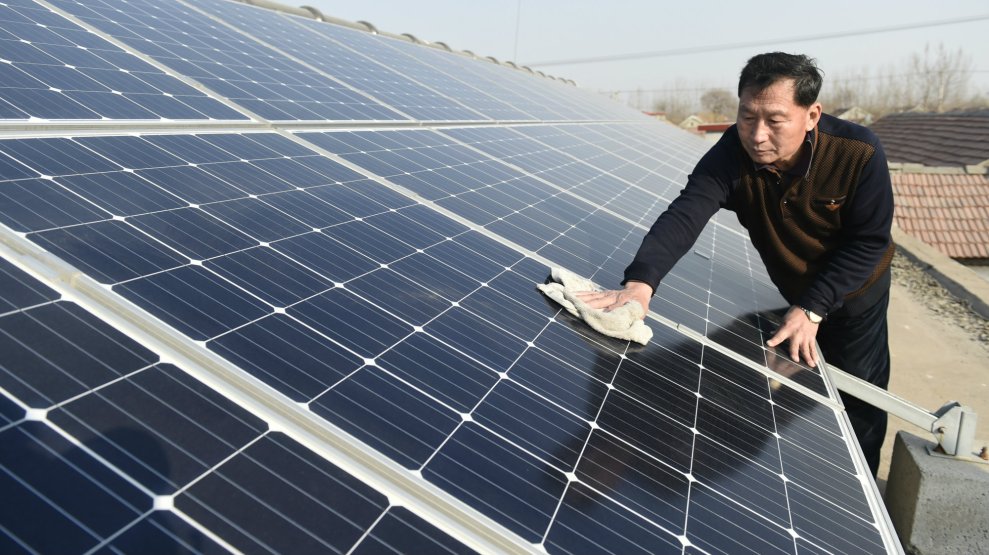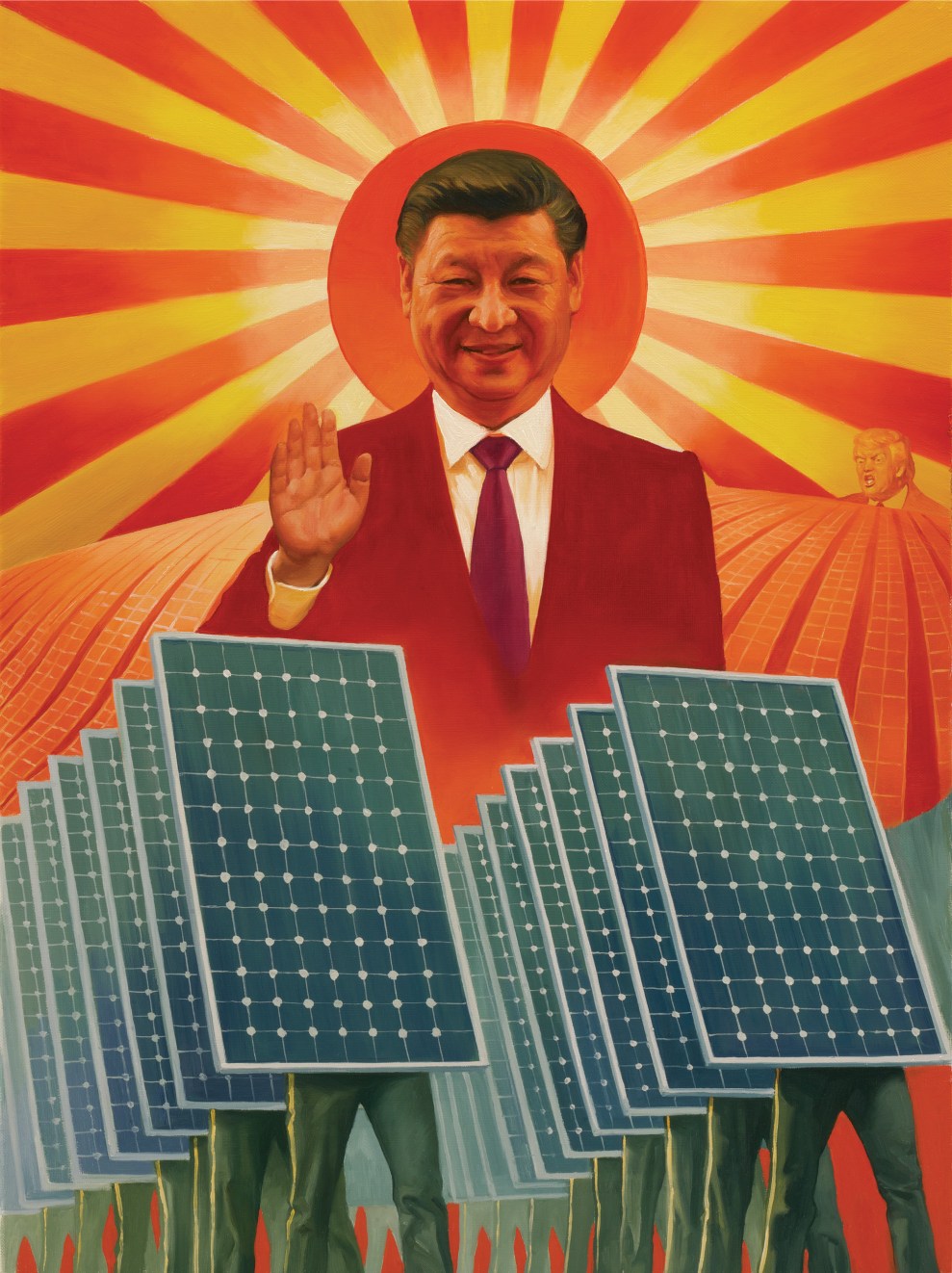
The headquarters of Huawei Technologies, the world’s largest maker of telecommunications equipment, sprawls across two square miles in the global manufacturing megalopolis of Shenzhen, China. At the center of its campus, surrounded by hulking office buildings of red brick and gray stone, sits a meticulously landscaped artificial pond. On the day I visited, two black swans glided across the water—fitting omens for the trajectory of Chinese technological power.
Most Americans have never heard of Huawei (pronounced HWA-way), but the company operates in 170 countries, employs 180,000 people, and in 2017 had revenue of $92 billion. These days it’s leveraging its telecom experience to corner what it sees as the next big thing: solar energy. The company’s main solar product is a suitcase-sized device called an inverter, which changes the direct current, or DC, that a solar panel produces into the type that can be fed into a power grid: alternating current, or AC.
Huawei is boosting its solar-inverter business not just by undercutting Western companies on price, but by beating them on innovation. Though inverters have been around for more than a century, many of the features Huawei offers are new, designed to improve the reliability of remote solar farms. A passive cooling system dissipates heat more reliably than fans, which are prone to breakage. And communications technology allows technicians to diagnose problems remotely, so they don’t have to venture into the field. Huawei is the top supplier of solar inverters globally, commanding 20 percent of the world market. With 800 solar-inverter engineers in research-and-development centers spanning China, Europe, and the United States, Huawei, which translates from Mandarin as “Chinese achievement,” presents a glimpse at the clean-energy juggernaut that is today’s China. In 2017, Huawei spent $13.8 billion on R&D. That amounted to 15 percent of its revenue—a higher portion than at Apple, Samsung, or Microsoft.
“Even though Western countries have some misunderstanding that we don’t innovate, we are confident,” Zhang Feng, the company’s head of solar-inverter R&D, told me. Yang Longjuan, the spokeswoman dispatched to shepherd me during my Shenzhen visit, put it more bluntly. “It’s like the Qing dynasty. You have to be careful,” she said, comparing the West today to the Chinese empire that lost power in 1912, a downfall historians ascribe in part to hubris. Any lingering Western belief that China doesn’t innovate “is the old impression of China,” Yang added, sitting in the back seat of a black Audi and thumbing between two smartphones as a Huawei driver sped us past the company’s Shenzhen offices and factories. “China is changing very fast.”
Listen to author Jeffrey Ball discuss China’s massive investment in clean energy innovation on the Mother Jones Podcast:
“Made in China” has long been seen as shorthand for shoddy. Whether it was fast fashion or toys, the rap on Chinese manufacturing used to be that it was all about leveraging cut-rate labor to knock off products designed in the West. Cheaper, certainly. Better, hardly. But that is changing fast—especially in the booming clean-energy sector. From solar to batteries to electric vehicles, China is rapidly gaining on the West in the most important arena of all: innovation.
In part that’s due to dysfunction in US clean-energy policy—which began before President Donald Trump but is intensifying under his watch. It’s also a result of Chinese President Xi Jinping’s belief that clean-energy innovation is critical to economic growth and the Communist Party’s survival.
“They are catching up, and in some cases I would say they are even getting ahead,” says Ajeet Rohatgi, who built one of America’s foremost solar-research laboratories at Georgia Tech, where he is a professor. About two years ago, Rohatgi saw federal and industry funding for his lab begin to wither as China was pouring increasing sums into its own labs. When Rohatgi toured Chinese facilities last summer, he was floored by their sophistication. “There is,” he says, “very impressive research going on in China now.”
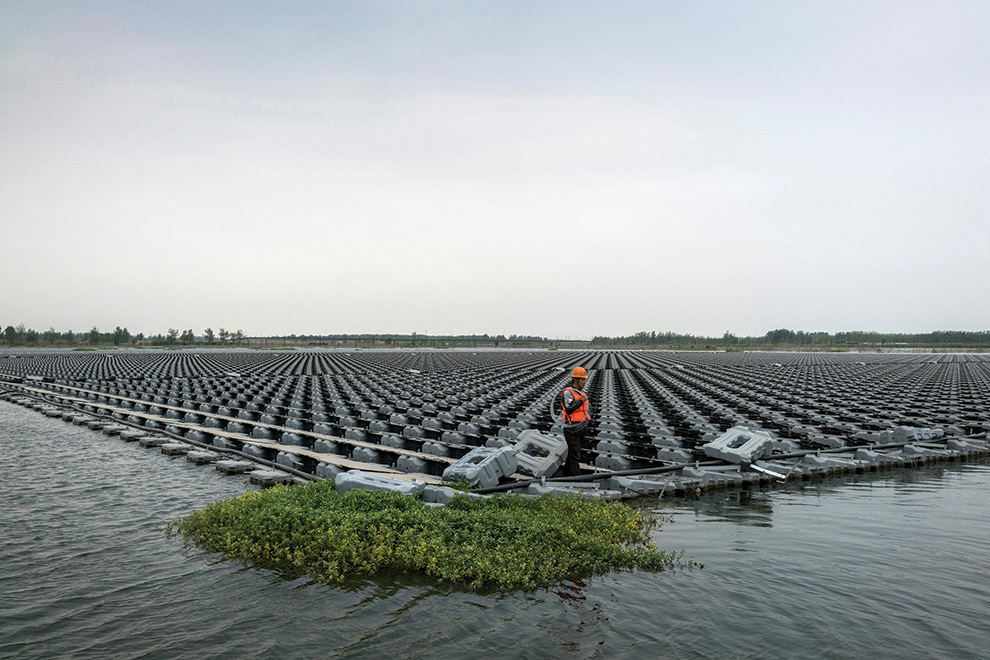
Adam Dean / Panos
The turnaround is particularly stunning given that, for decades, the United States was the clear world leader in clean-energy research and development. But America has fared poorly at moving those technologies from lab to market. That’s in part because government R&D grants have focused on basic research, on the theory that companies can do applied research themselves. China has taken the opposite approach, focusing public money on the technologies it thinks are likeliest to find a market fast.
This has handicapped US competitiveness, says Ilan Gur, who managed grants in solar at the Advanced Research Projects Agency-Energy (ARPA-E) during the Obama administration. “We are not capitalizing on some of the most transformative ideas in society right now in that no man’s land,” says Gur, who has since founded a fellowship program called Cyclotron Road that’s designed to speed products to market. “The United States has placed a pretty big down payment on some of the world’s best cutting-edge scientists in a variety of fields, and yet we’re not doing a very good job of capitalizing on that investment,” he adds. “Other parts of the world”—including China—“are quickly building the capacity to do cutting-edge science.”
Now, under President Trump, who has called climate change a Chinese “hoax,” the United States appears content to cede its lead. America has more than twice as many jobs in solar as in coal, and its installed solar capacity is expected to more than double over the next five years. Yet Trump’s 2019 budget proposes slashing the Energy Department’s renewable-energy and energy-efficiency funding by about 75 percent and killing ARPA-E altogether. (According to the Government Accountability Office, the Trump administration also violated federal law by withholding $91 million in fiscal year 2017 ARPA-E funding.) The administration wants to eviscerate several clean-energy loan-guarantee programs as well. Even if Congress staves off some of those cuts, Trump, by rolling back clean-power regulations and withdrawing from the Paris climate agreement, has undermined market forces that could spur invention.
In January, Trump imposed a 30 percent tariff on imported solar equipment. He claims this will protect US solar jobs, but because most of those jobs are in sales, project development, and installation, it actually endangers them by raising the prices for US consumers. GTM Research, an analysis firm, predicted in January the tariffs would depress solar installations by about 11 percent over the next five years. Since then, GTM’s near-term estimates have grown more bearish. In June, citing the tariffs, GTM downgraded by about 8 percent its projection for installations of utility-scale solar projects in the United States in 2019, and it said it expected even more projects to be canceled later this year. Because the government has imposed tariffs even as it doles out billions of dollars in tax breaks to subsidize the construction of solar farms, US consumers end up paying doubly for such projects.
The upshot is perverse. Trump’s policies threaten both innovation and installations without meaningfully improving the manufacturing terrain. “The policy the US has on solar has not been particularly smart,” says Jenny Chase, head of solar analysis for Bloomberg New Energy Finance. “Global solar companies that can do business anywhere are wondering why they should bother at all with this country.” And Trump’s criticism of China’s actions, she says, largely amounts to sour grapes. “A lot of what [China has] done is what the US would like to do but isn’t brave enough. What is called ‘unfair subsidy’ with China…would be called ‘intelligent strategic support’ if the United States did it.”
China’s solar-energy boom began not as a bid to save the planet, but as just another way to make a buck. In the early 2000s, governments in Europe rolled out juicy subsidies to spur renewable-energy development. Eager for a piece of that exploding market, Chinese entrepreneurs decided to harness their country’s manufacturing might to crank out solar panels less expensively than their European counterparts could. They pitched government leaders in a few key provinces, scored subsidies to build factories, and, leveraging cheap Chinese labor, began exporting vast quantities of solar panels to the West. Within a few years, those companies became major regional employers and utterly dominated the international solar-panel market.
But following the global financial crisis of 2008, European governments began rolling back their subsidies, causing orders for panels to dry up. Fearing for the survival of the market, the Chinese government decided to roll out a second wave of domestic subsidies—which funded solar farms along with factories. Soon China was not only the world’s largest maker of solar panels, but also the world’s largest generator of solar power. China’s solar push decimated the nascent US solar-panel industry, transforming a niche technology into a mainstream commodity where cost was king. But while US solar companies—most famously Solyndra—went belly up, American consumers’ appetite for solar soared.
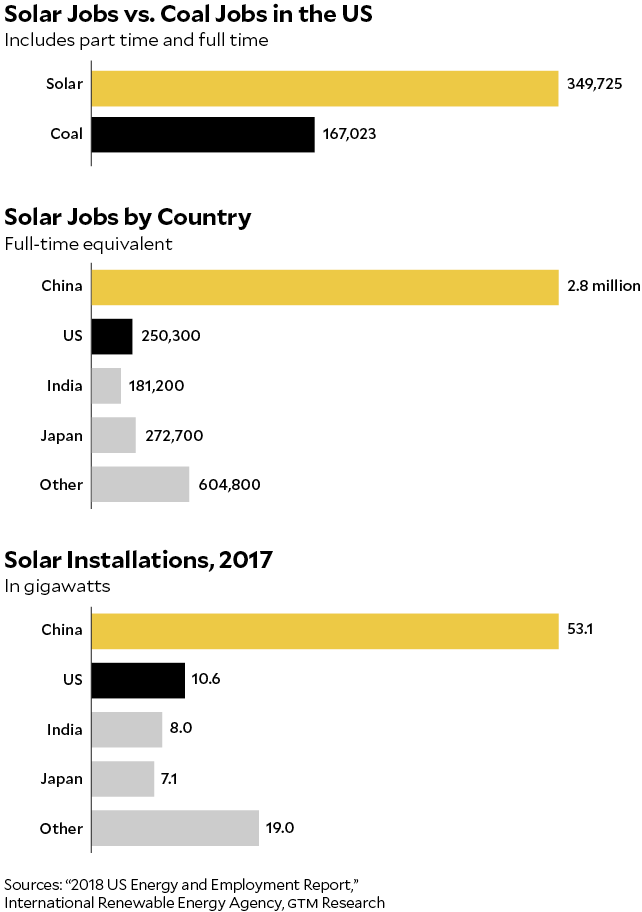
To maintain its commercial edge, China is now rolling out a third wave of clean-energy subsidies—not for factories or solar farms, but for R&D. China’s latest five-year plan, the government’s economic blueprint, sets out specific targets to reduce costs, increase growth, and improve efficiency in the solar sector. Beijing gives an advantage to manufacturers of more efficient solar panels, in what it calls its Top Runner Program. The efficiency bar rises annually, an impetus for continuous technological improvement. The goal is “to upgrade industry,” says Wang Sicheng, who worked for China’s Energy Research Institute and helped craft the program. “It is very important.” China is likewise incentivizing innovation in electric cars.
Beijing isn’t transparent about the budgets of most of its programs, so its total spending on clean-energy innovation is hard to calculate. But it’s clear that when the Communist Party decides to do something, it goes big. In 2017, $133 billion was spent on clean-energy technologies in China, more than twice the $57 billion spent in the United States, according to Bloomberg New Energy Finance. Many of the players in those projects are state-owned companies fueled by subsidies, so the numbers are a good indication of government interest. Last year, the government’s energy agency said China would spend another $360 billion on renewables by 2020. Case in point: China added almost 10 gigawatts of solar power in the first three months of this year—nearly as much as the United States installed in all of 2017.
For all that, China gets less than 2 percent of its juice from solar. The world’s leading carbon emitter draws 65 percent of its electricity from coal, and coal is projected to continue providing about half the country’s power for nearly two decades. But make no mistake: The Communist Party is dead serious about clean-energy technologies. It views them as necessary for political stability—a way to add jobs and sate the country’s booming energy appetite without worsening the pollution that has sparked public protests.
So, though President Xi claims China has “taken a driving seat in international cooperation to respond to climate change” as part of a “new era” of Chinese global leadership, China is really motivated by the lures of new industry and tolerable air.
If there’s a leaderboard for solar-energy innovation, it’s a spaghetti-like chart maintained by the US National Renewable Energy Laboratory, a research institute in Golden, Colorado, that’s funded largely by the federal government. The NREL chart traces records of how efficiently various kinds of solar cells turn sunlight into electricity. Scientists around the globe compete to improve these efficiency rates by hundredths of a percentage point; each notable gain is marked by a dot and credited to a lab. Between 1976, when NREL began publishing the chart, and 2013, all the dots went to labs in predictable centers of scientific innovation: the United States, Europe, and Japan. Then, in 2014, a lab in China scored a dot for the very first time. In 2015, the same Chinese lab earned a second dot.
That lab is a four-story building in a sprawling industrial park in Changzhou, a city of 3.5 million people near Shanghai. Atop the building sit two signs. One notes that this is the country’s State Key Laboratory of Photovoltaic Science and Technology, a designation that brings valuable government cachet. The other sign touts the private company whose headquarters house the lab: Trina Solar.
The State Key Lab designation burnishes Trina’s image with customers and those whom the company wants to recruit. And it makes it easier for the company to land government grants for R&D. This arrangement is different in two key respects from America’s government-funded national laboratories. US national labs tend to stress futuristic research rather than near-term technologies. And though they work with US industry, they don’t focus on building up single companies as national champions—let alone locate on a specific company’s corporate campus.
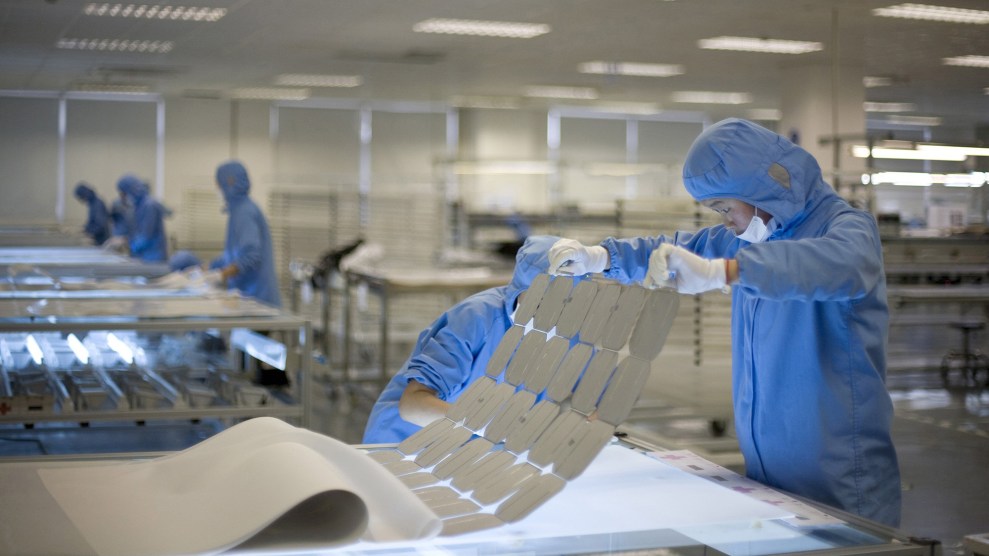
Silke Reents / Visum/Redux
Over the past decade, Trina has become one of the world’s largest solar firms, with offices across Asia, Europe, Latin America, and the United States. It has also become notably innovative, thanks to a quixotic 61-year-old Belgian scientist named Pierre Verlinden.
Verlinden has tired brown eyes, a ready smile, and a fire in his belly to make solar big. He used to be the head of R&D at SunPower, a Silicon Valley-based manufacturer known for its high-efficiency panels. In 2011, around the time Trina got permission to build the State Key Lab, it hired Verlinden via China’s Thousand Talents Program, which provides government money to lure foreign scientists. Verlinden moved to Changzhou with the mandate to whip Trina into a world-class solar-R&D program.
When I visited last fall, his office was big and plain—all function. A couple of solar panels were leaning against one wall. Along another were two mismatched dark-wood shelves brimming with solar-science books, including one Verlinden co-authored, and several awards.
When Verlinden arrived at Trina, the company had a grant to develop a variant of a high-efficiency solar cell pioneered by SunPower. Trina “started from nothing,” he said. The company was crawling with engineers who were impressive “experimentalists,” attempting a dizzying number of tests in hopes of a lucky strike, but who followed no discernible methodology. They were “shooting in the dark, trying to find the exit out of the tunnel.” A former professor, Verlinden set about holding formal classes in the scientific method. “We’re going to simulate where we are, simulate where we want to be, and then try to understand: In what direction do we have to go to change parameters?” he recalled teaching them. “We need to work systematically.”
Tracking what Verlinden did at Trina requires understanding how a typical solar panel is made. The process starts by heating quartzite into molten silicon, which is then purified, made into polycrystalline silicon, and sliced into thin square wafers, each roughly the size of a compact-disc case. After a wafer is chemically treated to improve its photovoltaic properties, it becomes a solar cell. Several dozen solar cells packed into a rectangular metal-and-glass container become a solar panel.
Before Verlinden joined Trina, its engineers had been noodling around with generating more electricity by making solar panels bigger. Verlinden told them their strategy was rubbish and that instead they should design better cells. “Focus,” he told them, “on the efficiency.”
Thus began several years of slogging for gains. Trina scientists were in the practice of testing each cell design on a separate silicon wafer. Verlinden told them that this presented a problem: Having one batch of cells for each new design introduced too many variables. So he had them put multiple cell designs on wedges within a single wafer. These “pizza wafers,” as Verlinden called them, allowed the scientists to collect more rigorous data. In 2013, the company installed a new assembly process dubbed the Golden Line, for which he taught workers various tricks, including how to avoid soiling the cells they were making.
The two dots that Trina scored on the NREL chart were the result of this kind of systematic work. Verlinden has since left the company, which is now diversifying into batteries and electric cars, fields in which it hopes to replicate his hunt for efficiency.
Xi’an, the capital of China’s Shaanxi province, was the eastern terminus of the Silk Road and is near the resting place of the terra-cotta warriors, human-sized sculptures buried with China’s first emperor around 200 B.C. On the day I visited the city of about 6 million people, I encountered a more modern phenomenon: smog so thick that shapes two blocks away were hard to make out. Dirty air is such a scourge in Chinese cities that it’s seen almost universally as an economic liability and a political threat. The biggest culprit is PM 2.5, particulate matter that’s 2.5 micrometers or less in diameter, small enough to easily lodge in the lungs. Concentrations of PM 2.5 in major Chinese cities can be 10 times or more the level the World Health Organization classifies as dangerous. Respiratory masks are so common they’ve become fashion symbols; some have stripes, polka dots, or cartoon characters.
I’d come to visit Longi Green Energy, a midsize company whose stock price has soared over the past year. In 2017, Longi spent 7 percent of its revenue on R&D, about double the proportion allocated by leading US solar companies. Longi’s bread-and-butter product is that elemental component of a solar panel: silicon. In 26-foot-tall furnaces that burn at 1,450 degrees Celsius, Longi cranks out shimmering, 12-foot-long cylindrical ingots of monocrystalline silicon, a variety that yields particularly efficient solar cells.
Founded in 2000 to make silicon wafers for the semiconductor industry, Longi diversified into solar in 2004, part of the broader scramble to exploit Europe’s renewable-energy subsidies. Like most Chinese solar firms, Longi has benefited from government subsidies. But where most Chinese startups rely on cheaper polycrystalline silicon, Longi, having already invested in monocrystalline manufacturing, decided to stick with the more efficient material and work on slashing costs.
The task fell to Li Dingwu, Longi’s head of silicon R&D. A Longi lifer who never went to graduate school, Li is rail-thin, with big ears, big glasses, and a perfunctory haircut. On the morning I met him, he sported a Longi windbreaker and offered up a Chinese proverb to illustrate how Longi wasn’t scared to bet on a different type of silicon. “The first baby,” he said, “is never afraid of a tiger.”
Monocrystalline silicon was actually developed a century ago by a Polish scientist named Jan Czochralski, and it’s used to make semiconductor chips around the globe. A rod containing a single-crystal “seed” is inserted into molten silicon and rotated; as silicon attaches, the crystal thickens and lengthens, ultimately forming a cylindrical ingot.
The process is hellishly energy-intensive. So one of Longi’s first steps was siting a new factory in Ningxia province, where electricity costs a fraction of the price in Xi’an. It’s so cheap because it’s produced by burning coal. But Longi’s drive for efficiency has overhauled the manufacturing process as well. Specially designed furnaces can now produce several ingots simultaneously. And the furnaces are “rechargeable”: When one batch of ingots is finished, another batch can be started without opening the furnace, saving massive amounts of energy.
It is a point of pride at Longi that this improved design came from within the company rather than an outside consultant. Standing at a whiteboard, outlining his points with a marker, Li summoned a soccer analogy. Some companies, he said, operate like Spain’s Real Madrid; they “buy a lot of superstars.” But Longi models itself after Juventus, the thriftier Italian powerhouse, which, Li explained, “uses local talent.”
Wang Yichun, a Longi manager, guided me around the plant. We were sheathed from head to toe in white suits to prevent contamination. Fourteen identical furnaces occupied the long, cavernous hall. I stopped at one and looked through a small window. Against the orange-hot background of molten silicon, I could make out the tiny ingot, twisting like a magical lollipop that grew ever so slightly with each revolution. The furnace’s video screen displayed columns of data that Wang translated for me: pulling speed, temperature, ingot diameter. And then she stopped. The next piece of information, she said, is “something really important. I can’t tell you.”
A few dozen yards away, workers opened up one of the furnaces, revealing the “hot zone”—the crucial part of the furnace in which the heat is distributed. I tried to take a closer look and was stopped. “No one,” Wang told me, “will let you know the design. I’m sorry.”
In part because of such secrets, Longi produces particularly efficient solar cells at a competitive price. That’s why its wafers are used by a who’s who of the global solar industry, including, according to Longi, Elon Musk’s Gigafactory in upstate New York. That’s right: A factory widely billed as ushering in a resurgence of American solar ingenuity gets some of its most important components from China.
Even the best solar panels can’t solve renewable energy’s most vexing conundrum: The spots where the sun shines the brightest or the wind blows the strongest can be hundreds or thousands of miles from the cities in which most people live. No country has bigger solar farms on one flank, and bigger cities on the other, and more miles of territory in between them, than China. So China has perfected a holy grail of clean-energy technology: ultra-high-voltage (UHV) transmission lines that have two to three times the capacity of conventional power lines.
State Grid, every bit the government-owned colossus its name implies, is the global leader in UHV. In 2016, State Grid inked revenue of some $315 billion, more than 10 times as much as America’s largest power producer. In fact, State Grid is the world’s biggest energy company of any sort, and it ranks second on the Fortune Global 500 list, behind only Walmart. Former Chairman Liu Zhenya proposed building a global electricity network, a great green grid that would link renewable-energy projects from around the planet and make fossil fuels largely irrelevant.
Some people, including at State Grid, question whether Liu’s grand scheme is viable. But there’s no doubt that when it comes to the technology that would underpin a global grid, UHV transmission lines, State Grid is dominant. It has built 20 UHV lines in China and is erecting others in Brazil and India. The average line costs $4 billion.
State Grid’s test facility sits an hour’s drive from the center of Beijing. Outside the facility’s tall gate on the afternoon I visited, an elderly peddler hawked popcorn made over an open fire. Past the gates were cavernous test buildings and highly charged rods, rings, and towers. It looked like a cross between Disney’s Epcot Center and Dr. No’s lair.
One test hall simulates lightning striking a transmission line. Another tests the effects of smog on the longevity of a piece of equipment called an insulator. Air pollution contains sodium, which corrodes insulators by enveloping them in what my guide, a young electrical engineer named Liu Bo, called “salty fog.” She lowered her voice to level with me. “You know, the pollution in China is kind of heavy. We can’t deny it,” she said. Preventing insulators from corroding is “really difficult for us, because the pollution problem is so heavy.”
Since about 2004, State Grid has spent about $400 million on UHV experimentation, funding researchers across the country—including Zeng Rong, a 46-year-old electrical-engineering professor at Tsinghua University, often dubbed China’s MIT. For the past five years, Zeng has been developing a new circuit breaker able to instantaneously turn off in the event of an electrical surge. Although Chinese companies now make most of the components of that breaker, Zeng still needs to buy one particularly complex part from Europe or Japan. Within five years, he predicts, China will be able to make that part itself.
Over a plate of Sichuan-style vegetables and pork in the cafeteria of a Beijing hotel, Zeng explained that he receives all the funding he could want and oversees a lab with 13 graduate students, whom he pays a fraction of what researchers in the United States would make. Sure, he typically works 12 hours a day, seven days a week, leaving little time for his family. But he has no regrets. “You have plenty of money. You have very good students. You have very good instruments. So you have no reason to waste time. You need to work very hard,” he said. “You can do what you want to do. I think we are very lucky.”
Rohatgi, the Georgia Tech solar scientist, is a generation older than Zeng, better known internationally, and markedly less optimistic. He has witnessed China’s solar might, first in manufacturing and more recently in innovation. And he bears the scars of both.
Rohatgi, 68, grew up in Kanpur, India, emigrated to the United States in 1971, and ultimately got tenure as a professor at Georgia Tech. His lab, in a squat building on the university’s leafy Atlanta campus, is one of the best-known solar-research sites in the United States. For years, it had ample resources: an annual budget of about $3 million and some 20 researchers.
In 2007, Rohatgi founded a solar-panel company to commercialize the technology he had developed in his lab. He called it Suniva. Its funders included prominent Silicon Valley venture capitalists, private-equity giant Warburg Pincus, and Goldman Sachs. Suniva opened factories in Georgia and Michigan. At its height, in 2015, it was the third-largest manufacturer of solar panels on US soil, according to IHS Markit. Suniva even scored a big investment from a Chinese solar manufacturer. But ultimately it couldn’t compete with cheaper imports, and it withered along with much of the rest of the US solar-manufacturing industry.
Up until about 2014, Rohatgi managed a research consortium funded by some 20 companies and by the National Science Foundation. “We had so many members, so much money, so much interest,” he says. “It was a lot of fun.” But as China’s solar manufacturing intensified, the US companies putting money into the consortium shrank—and in some cases failed. The consortium shut down. And with federal solar-R&D investment declining, funding for the Georgia Tech lab is about half its former level.
US government research managers, Rohatgi laments, want to fund solar technologies they see as likeliest to leapfrog China, rather than ones, like those Rohatgi works on, designed to squeeze out incremental improvements. The United States is “funding some very far-out concepts,” he says, “but those are so far out that you don’t know when they will become real, if at all.”
Meanwhile, Chinese solar companies, backed by their government, are upping their innovative game. There is “nothing to stop them from doing next-generation R&D,” he says.
Rohatgi is committed to expanding solar wherever that can happen, so he is in discussions with Chinese companies to see if they can support his Georgia Tech lab. “They have been talking to me, and I am looking at it,” he says. “I want to do some collaborative R&D. You have to look for some funding or you stop.”
Huawei, founded 30 years ago by a military engineer, still earns most of its money by making the unsexy guts of wireless-communication systems like “base stations,” which transmit cellular signals. It began selling solar inverters in 2013, when it decided that renewable energy was ripe for growth and that inverters, whose underlying electronics have much in common with base stations, were a logical, lucrative market to crack.
Recently, Huawei made another strategic move. It stopped creating the sort of inverters that had long dominated the solar market: “central” inverters, massive machines capable of serving entire solar farms. Instead, Huawei shifted all its production to smaller “string” inverters, each of which serves only a tiny portion of a solar farm. Smaller devices are preferable, the company concluded, because if one breaks, it knocks out only a subset of the solar project and can be more cheaply and easily replaced. Central inverters are “a stupid business,” says Richard Hu, who formerly headed Huawei’s solar-inverter R&D program and now runs the company’s Silicon Valley-based sales office. “We should be smarter.”
Huawei, like rival ZTE, faces accusations from US regulators that its phones pose a national security risk. (The companies have denied this.) In May, much to the ire of Congress, Trump intervened on behalf of ZTE—“Too many jobs lost in China”—only to backtrack. It was another weird lurch in the unfolding trade war with China. Meanwhile, Huawei’s solar business continues to grow.
Last summer, the company threw a boozy bash for the solar industry in San Francisco. I wandered around the rented gallery, where the partygoers downed “kiwiburgers” with fried quail eggs and where bartenders at the boutique-whiskey station had the requisite bushy beards and bicep tattoos. Renewable energy, once a pipe dream of the hemp crowd, has become sexy, lucrative, and global. The notion that the United States has a lock on clean-energy innovation will seem as antiquated in 10 years as the once-prevalent belief that Detroit designed the best cars. China, with its noxious smog and voracious energy appetite, has compelling reasons to innovate. And the Trump administration seems more interested in protecting coal producers than in furthering renewable-energy research. “If the US doesn’t do the R&D, then China will,” says Chase, the Bloomberg solar analyst. “In fact, China is doing it. It just means that the US will become less and less relevant to the solar industry.”
Recently, over dinner in China, I was talking with two young engineers. The conversation turned to clean-energy innovation, at which point one of them smiled, borrowed my notebook and pen, and gave me a short lesson in Mandarin. He wrote down two Chinese phrases, each containing four characters. The two phrases are pronounced identically—Zhongguo zhi zao—and three of their four characters are the same. But one makes all the difference. The more traditional phrase translates as “made in China.” The other, steadily gaining currency, means “made in China wisely.”
